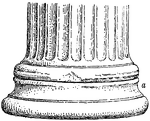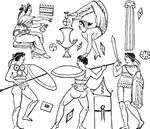Clipart tagged: ‘antiquity’

Greek Griffin
The Greek Griffin is associated with Antiquity and fire, usually appears on Candelabras and friezes.…

Griffin Renaissance
The Renaissance Griffin is associated with Antiquity and fire, it appears on Candelabras and friezes.…

Roman Griffin
The Roman Griffin has the body of a Lion and the head and wings of an Eagle. The Griffin is usually…

The Base of an Ionic Column at the Erechtheum
The base of the column, torus, displays a concave molding called a scotia. This type of base was not…

Pyrrhic Dance
"The most famous of all the war-dances of antiquity, is said to have received its name from one Pyrrichos,…
